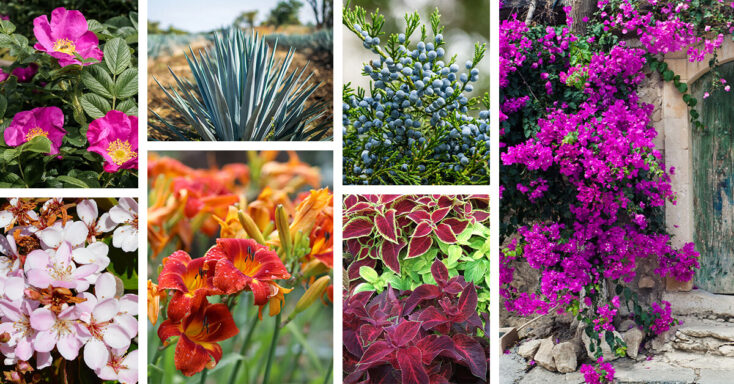There are many growing locations that present such unique challenges that a large percentage of popular plant species are not able to survive in them. One such location is a beach landscape that is either on or near the ocean shore. Such places often feature strong winds and are always high in salinity. As such, if you are not able to find salt-tolerant plants for your beach landscaping plan, you cannot expect your gardening efforts to be a success. To help you find the best and most attractive salt-tolerant plants for your property, we’ve collected 21 of the top options in this article.
Key Takeaways
Salt-tolerant plants for beach landscaping are not exclusive to any specific genus or broad plant group. With that being the case, each of the entries on our list will feature unique information that is exclusive to that species. However, you’ll also find that this list also features the following recurring key takeaways:
- Plants that are specifically salt-tolerant may be some of the only species you can grow if you live near the ocean.
- Salt-tolerant plants combine durability and beauty.
- Some plants on this list are more salt tolerant than others.
- Salt-tolerant plants don’t necessarily require high salinity conditions to survive.
- Salt-tolerant plants can have a wide range of other growing preferences.
21 Durable Types of Salt-Tolerant Plants for Beach Landscaping with Ornamental Appeal
1. Agave (Agave americana)
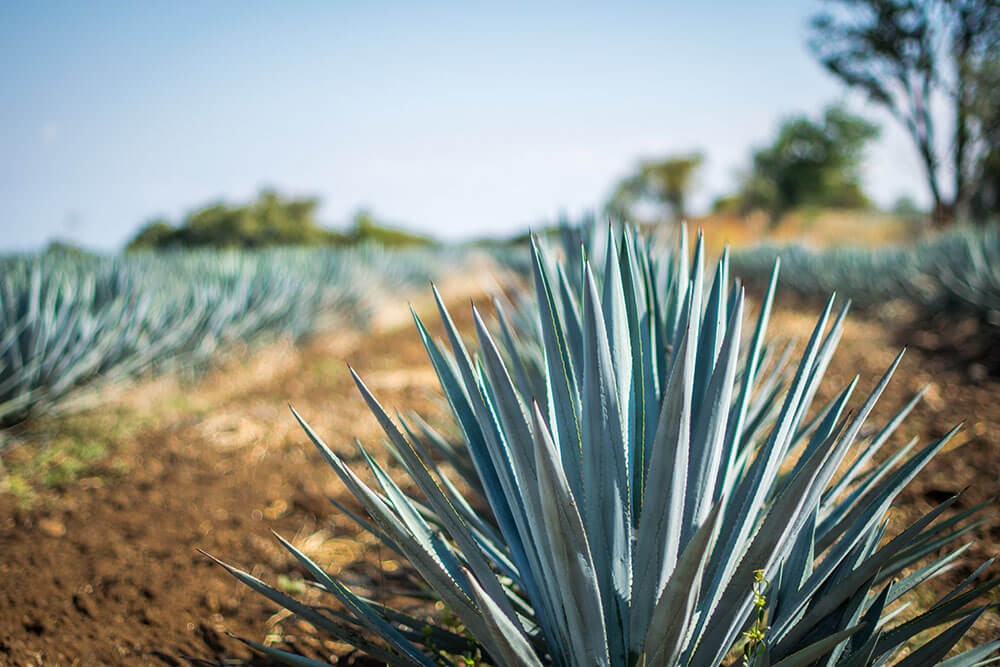
You may recognize the agave plant as one of the primary ingredients in tequila. However, did you know that this plant can also serve as an attractive, salt-tolerant, ornamental species in beach landscapes? Since they thrive throughout Mexico, agave plants love hot weather and can tolerate the salinity that is often present in those conditions. When it comes to ornamental features, the foliage of the agave plant is most notable. This plant has long, pointed leaves that are similar in shape to that of an aloe vera plant. That foliage also has a unique blue hue that you’ll love.
2. Algerian Ivy (Hedera canariensis)
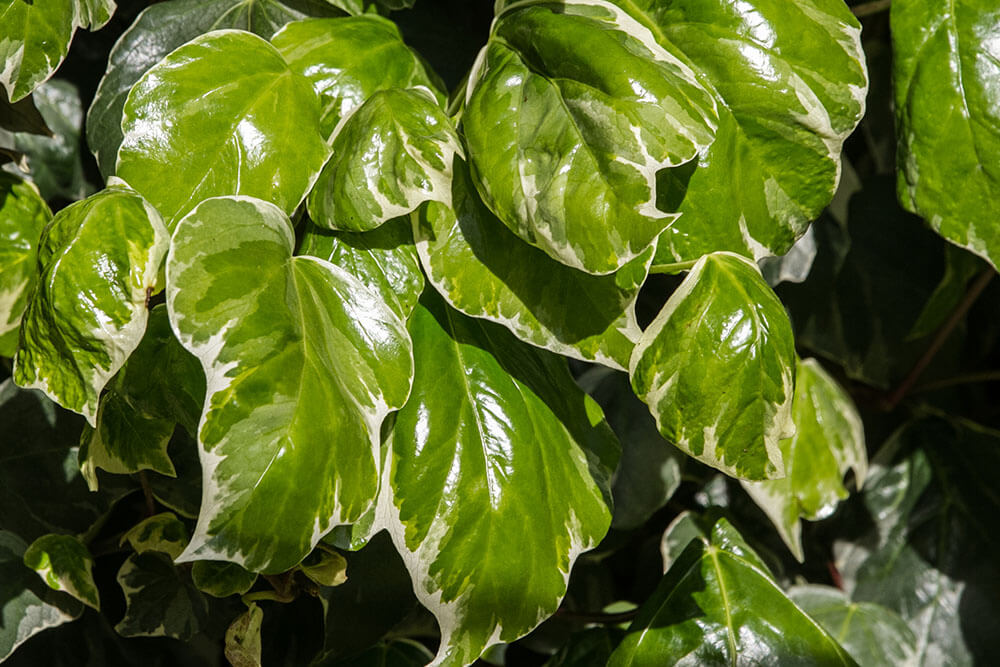
The Algerian ivy plant is not only a beautiful broad-leaved evergreen vine, but it is also a plant that can resolve multiple common gardening issues. First, in keeping with the theme of this list, the Algerian ivy plant is tolerant of salt. Additionally, Algerian ivy plants can grow surprisingly well in areas that don’t receive much light. The best part is that you can grow the Algerian ivy plant as either a groundcover or as a climbing plant. Either way, this plant will provide beautiful trident-shaped leaves that are often variegated with patches of creamy white on the margins.
3. Bayberry (Myrica pensylvanica)

With a name like bayberry, it is no surprise that this species will thrive in a growing location near the beach. The bayberry plant is a medium-sized shrub that is native throughout North America. This plant provides a set of dense, dark green leaves and a set of fruits that are more ornamentally valuable than you might first guess. After the flowers fade, a bayberry shrub will develop fruits that are small, rounded, and light blue. Those fruits appear in clusters of varying sizes, and they attach themselves directly to the branches of the bayberry plant.
4. Bougainvillea (Bougainvillea)
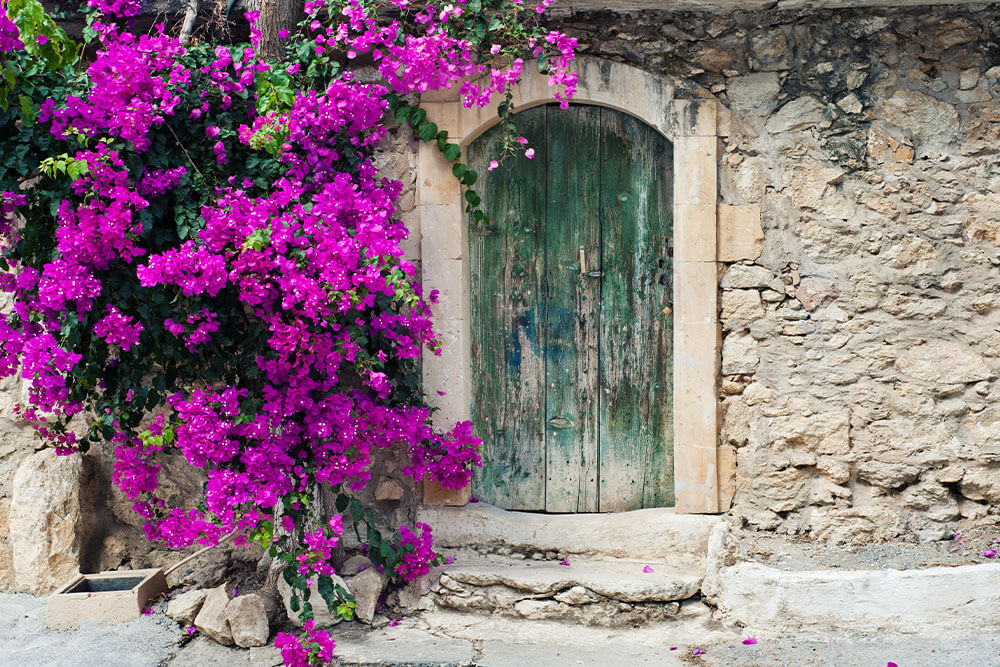
Compared to other plants on this list, the bougainvillea is not the most salt tolerant. However, it is safe to say that this plant is at least mildly salt-tolerant and may survive in some highly salty areas nonetheless. What’s most remarkable about this plant is the combination of its growth habit and its blooms. The bougainvillea plant is a climbing vine that looks great on fences and garden walls. This plant also blooms with copious amounts of flowers that create a broad swath of vibrant color every year. Those flowers commonly come in shades of red, pink, and purple.
5. Coleus (Plectranthus scutellarioides)
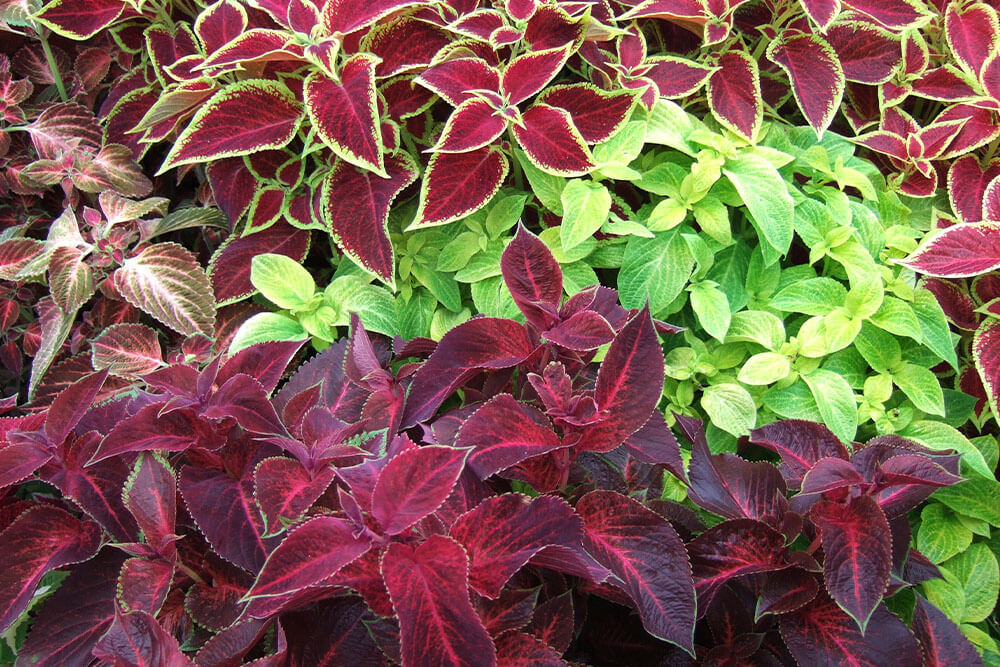
Coleus plants are well known for having some of the most colorful foliage you can imagine. The leaves of a coleus plant come in more amazing colors than we can spend time mentioning here, as all coleus enthusiasts know. But what many people don’t know is that coleus is also a perfect salt-tolerant option for beach landscaping. However, this plant has a preferred hardiness zone range of ten to 11, which means that most people throughout the United States will need to grow coleus as an annual plant. Still, the leaves of the coleus plant are guaranteed to impress you, even if you are only able to witness them for a few months of the year.
6. Creeping Juniper (Juniperus horizontalis)
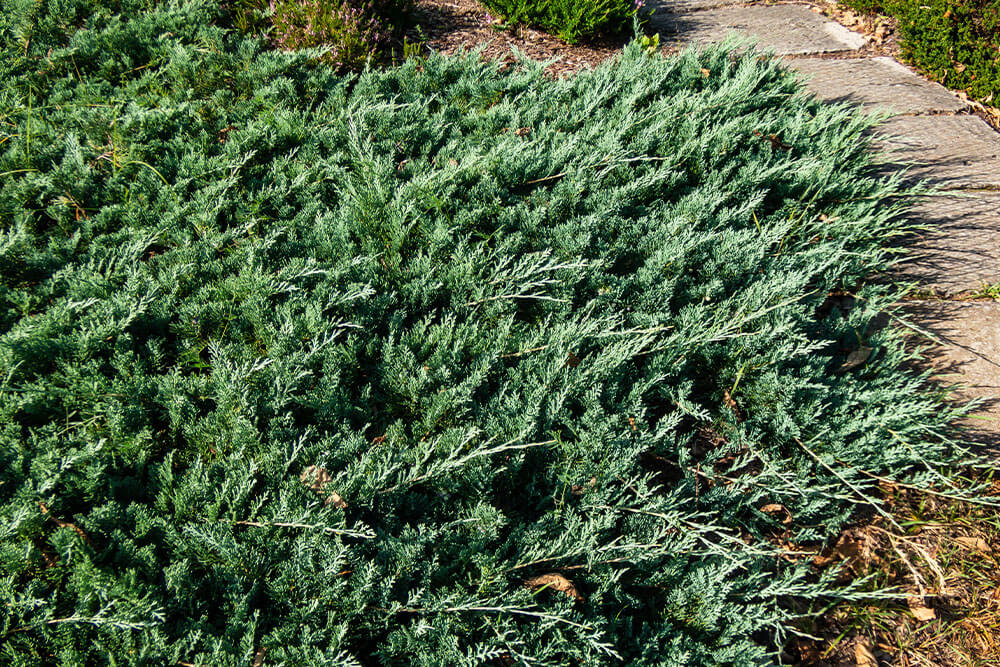
If you live in an area near the beach and you need a consistent evergreen ground cover, then the creeping juniper plant is one of the best options for you. This species reaches a total height of less than one foot tall in most cases, but it will spread over an incredibly wide distance when conditions are right. As it spreads, the bluish-green foliage of the creeping juniper plant will form a dense and consistent mat that effectively covers the ground. Creeping juniper plants also produce small round fruits that are also light blue and a pleasure to look at.
7. Daylily (Hemerocallis)

The popularity of daylilies in landscaping cannot be overstated. In fact, daylilies are among the most popular and ubiquitous flowering perennial species you can imagine. These plants adapt well to many different conditions, including beach areas that are high in salinity. Additionally, the popularity of daylilies has led people to create countless cultivated varieties. Each of those varieties comes with different blooming characteristics, which can include varying bloom times, differing mature sizes, and enough color options that you will never run out of daylilies to choose from.
8. Dwarf Indian Hawthorn (Rhaphiolepis indica)
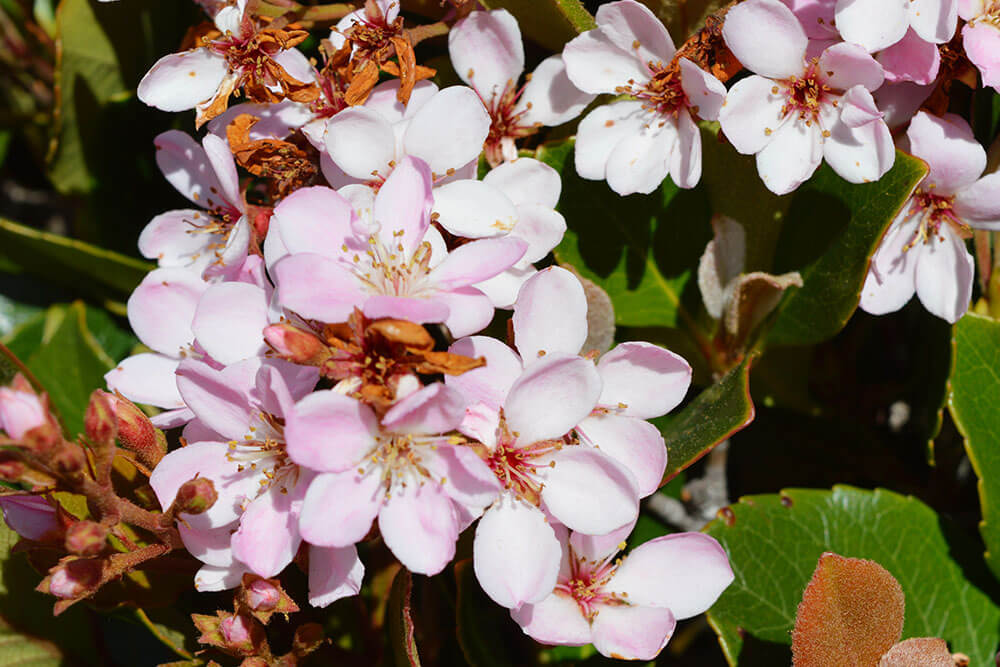
Most hawthorn plants are lovely flowering trees that reach a medium size, but the dwarf Indian hawthorn is a bit different. Admittedly, dwarf Indian hawthorns feature incredible lightly colored blooms, as is true of other hawthorn species. However, where the dwarf Indian hawthorn differs is in its size and its ability to survive in adverse conditions. Most dwarf Indian hawthorns will be more shrub-like than tree-like and have a mature size that is around five to six feet in both height and spread. Likewise, the dwarf Indian Hawthorn also differs from other hawthorns thanks to its ability to grow well in areas where salt is highly prevalent.
9. Eastern Red Cedar (Juniperus virginiana)
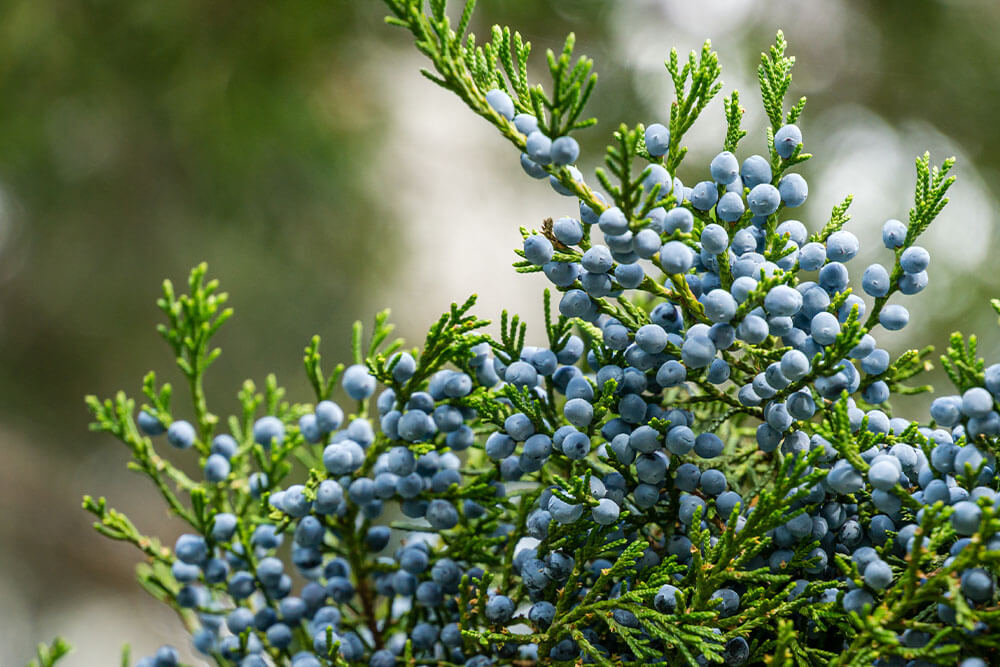
The eastern red cedar is a fantastic plant to grow if you want to add some consistent background greenery to your beech landscaping. Eastern red cedar trees are needled evergreen trees that often have upright oval-shaped canopies. These trees also have cones and bark that are interesting due to their light brown color and the way in which it peels in long strips as the trunk expands. Eastern red cedars can prove to be highly functional garden plants as well since they can provide privacy and wind screening if you plant them as a hedge.
10. Echeveria (Echeveria)
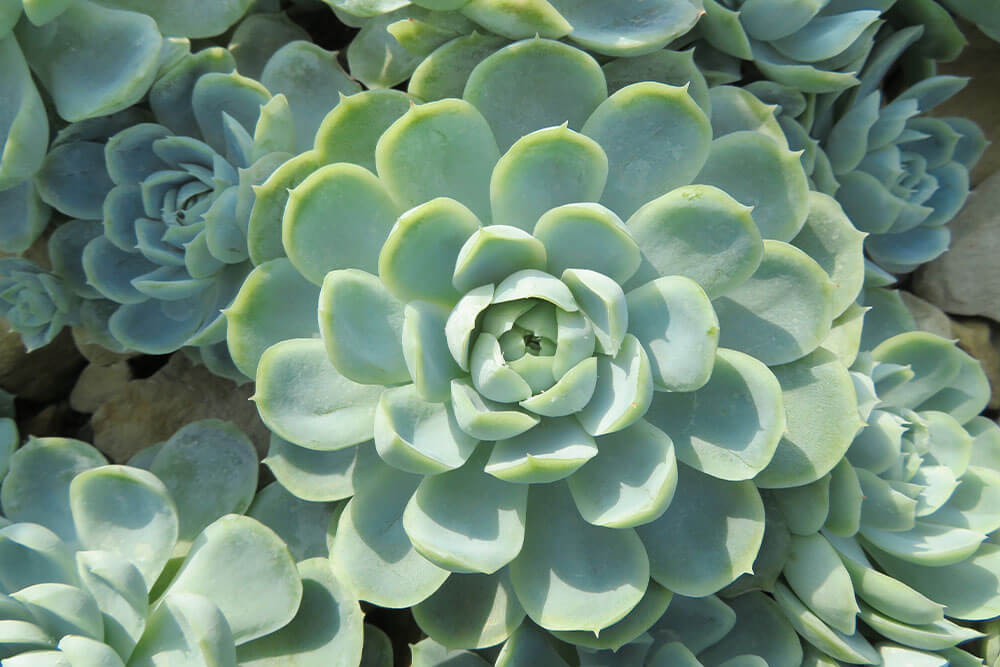
When you imagine a beach landscape full of salt-tolerant plants, you likely don’t include succulent plant species in the picture you conjure up in your mind. Despite that common perception, many succulent species are able to withstand hot temperatures and conditions that include high salinity. The echeveria plant is a perfect example of that fact. However, similar to other plants that appear on this list, the echeveria plant cannot survive outdoors throughout the United States. As such, anyone in an area colder than hardiness zone 9 will need to overwinter their echeveria plant or grow it indoors entirely.
11. English Ivy (Hedera helix)
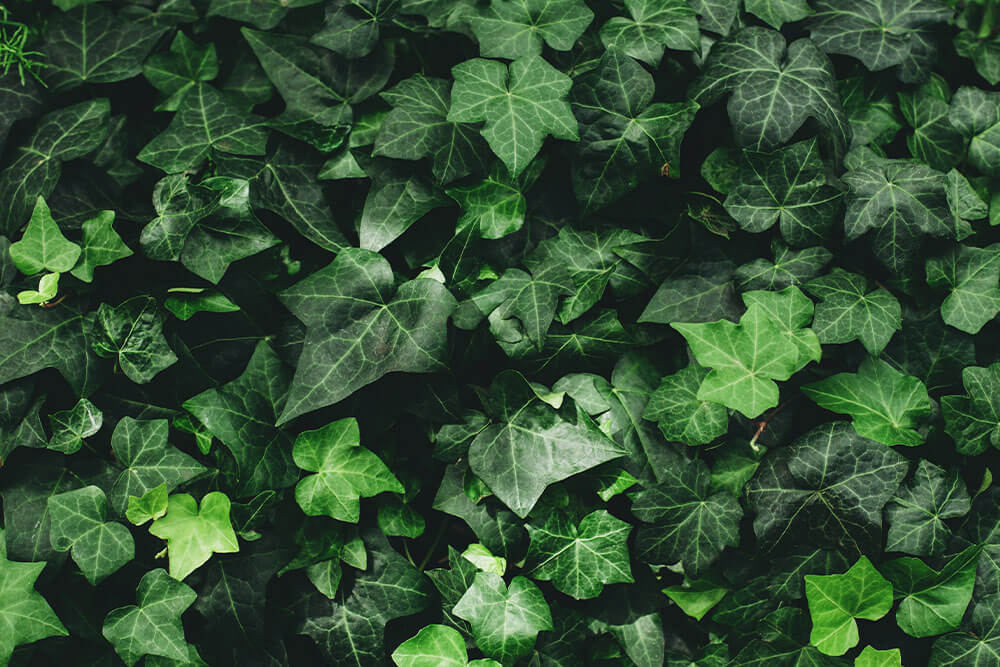
English ivy is a classic ivy plant that has amazing foliage. Each leaf has a distinct trident shape and often has a dark, glossy green surface. With that said some versions of this plant are even more impressive because they also show variegation on their leaves. Still, no matter which version of the English ivy plant you grow, you can expect it to climb nearby structures readily and remain tolerant of salt throughout its life. Of course, like most other climbing vines, the English ivy plant can also act as an effective ground cover, depending on how you choose to grow it.
12. Mexican Fan Palm (Washingtonia robusta)
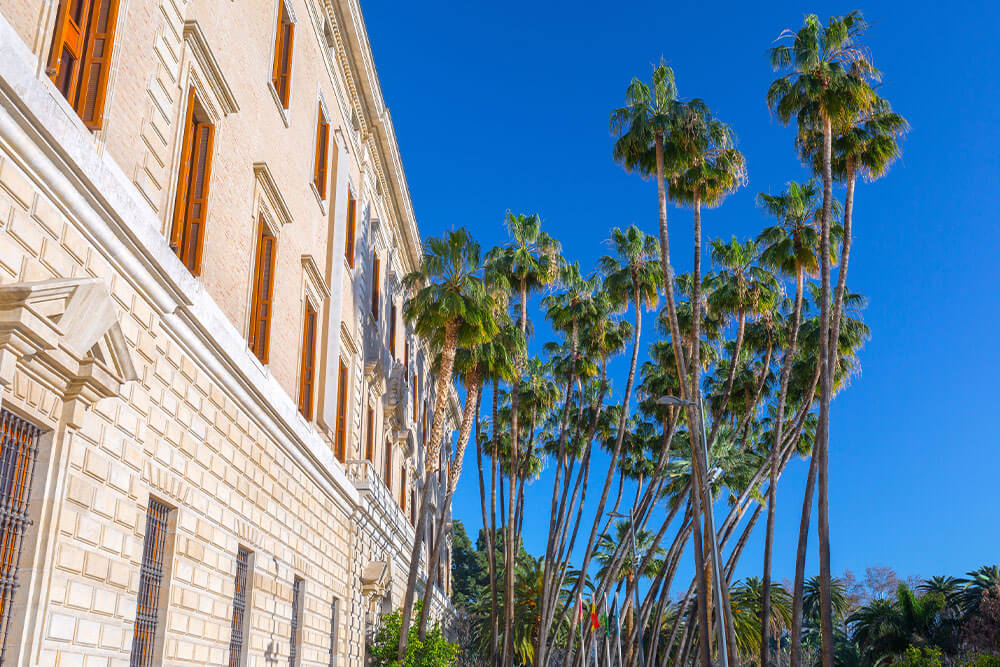
To some, no beach landscaping scene is complete without the inclusion of at least one type of palm tree. In fact, palm trees are so popular near the ocean that they have become somewhat of a symbol of a beachfront getaway. Here we have the Mexican fan palm tree, which is as impressive as any other palm and has large fan-shaped fronds. Since these trees thrive near the ocean, they are also highly salt tolerant. When the right conditions are in place for a Mexican fan palm tree, you can expect this plant to be 70 feet tall or more when it is mature.
13. Palmetto (Sabal palmetto)

After the previous entry, it is only fitting to follow up with another amazing palm tree variety that you can add to your beach landscape. The palmetto, which goes by the botanical name Sabal palmetto, is a bit smaller than the Mexican fan palm tree, as it reaches about 50 feet tall at maximum. However, the palmetto is similar to the Mexican fan palm tree in that it has large fan-shaped fronds. If you are diligent about pruning spent fronds close to the trunk, you can create a captivating crosshatch pattern that follows the entire length of the trunk up to the canopy.
14. Pin Oak (Quercus palustris)
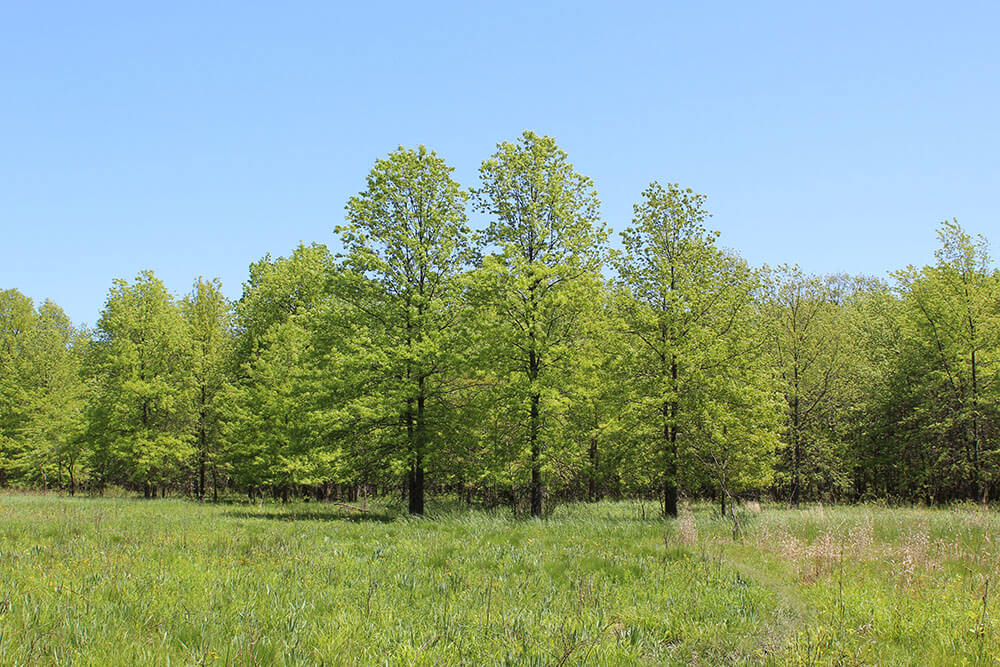
Pin oak trees are incredibly popular as shade trees and street trees. However, the salt tolerance that pin oaks have also made them a viable option for growing areas that are near the salty sea. But although pin oaks are tolerant of salt, there are other soil conditions that can cause them issues. Mainly, if the soil in which a pin oak grows is too alkaline, the tree will likely develop chlorosis, which can turn the leaves a lime-green color. However, this condition is not life-threatening, and the pin oak remains an excellent plant option for many scenarios.
15. Red Oak (Quercus rubra)
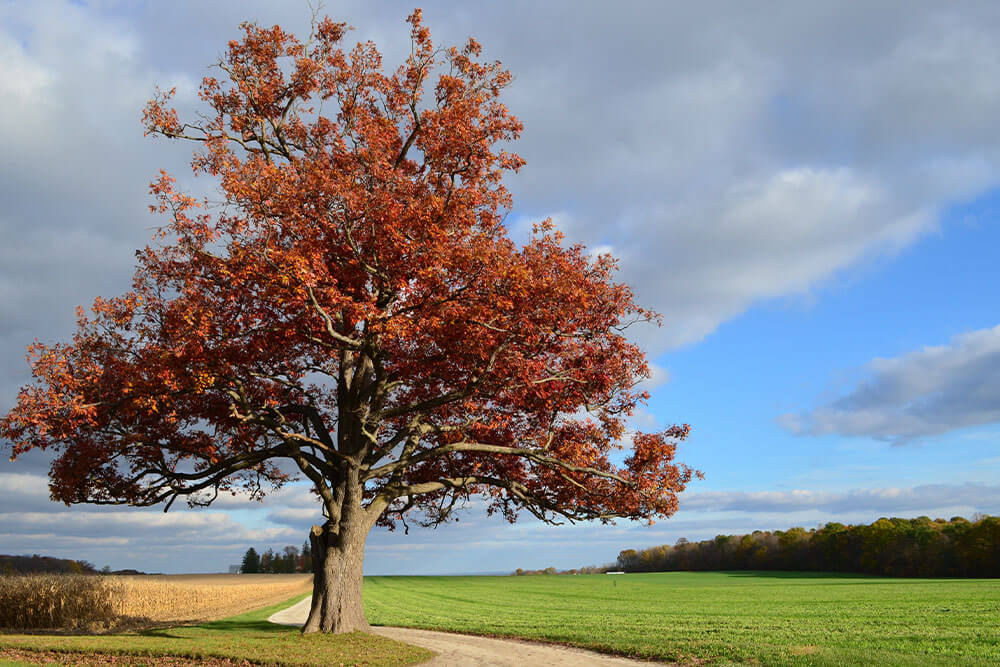
The red oak tree is a quintessential deciduous species throughout the forests of the eastern half of the United States. This tree grows tall and forms large shade-providing groves that create a lovely woodland scene. But while this plant is typical of woodland settings, it is also suitable for areas near the ocean due to its salt tolerance. As the red oak grows, it will provide large leaves, countless acorns, and plenty of shade to help get some reprieve from the hot summer sun. As such, the red oak is a surprisingly relevant option for those who are planting a beach landscape.
16. Rugosa Rose (Rosa rugosa)
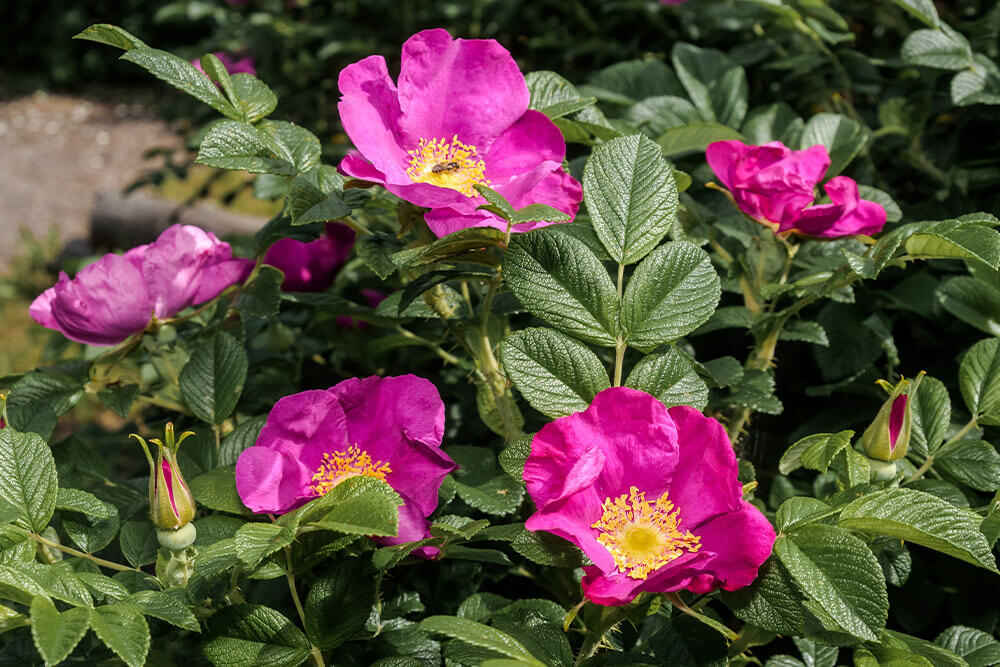
While some plants tolerate salinity, other species thrive in it. The rugosa rose is a plant that belongs well within that second group. In fact, this plant loves salty beachfront areas so much that it can spread readily and form large colonies. However, the rugosa rose is not just a durable plant that adapts well to salt and sand. It is also a beautiful plant that has showy flowers and fruits. Each flower is purple, with a yellow center, and gives way to a reddish-orange rose hip that is the fruit of this plant. Since those fruits are so easy to notice, this plant sometimes has the name beach plum.
17. Staghorn Sumac (Rhus typhina)
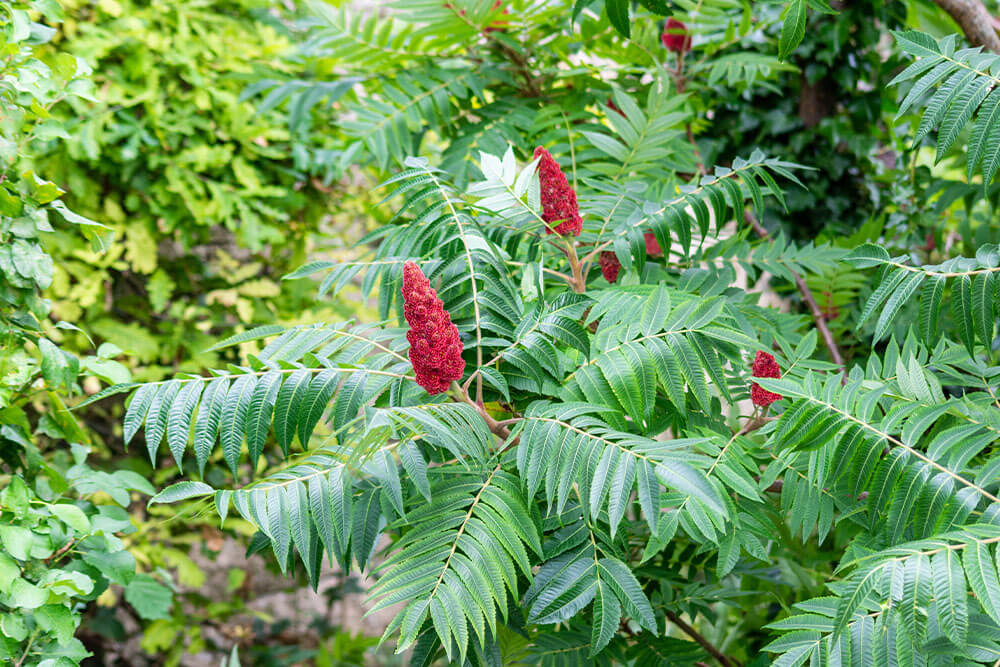
We admit that the staghorn sumac is not often a plant that people choose to grow in their residential landscapes. However, at the same time, we cannot come up with a viable reason why that is the case. Staghorn sumac plants are large shrubs with a beautiful branching habit and fuzzy stems and branches. At the top of those branches, you’ll find the large seed clusters that this plant produces. Those seed clusters are more than a few inches long and have a conical shape and a deep red color. That appearance makes the seed clusters as attractive to humans as they are to the birds and other animals that feed on them.
18. Virginia Creeper (Parthenocissus quinquefolia)
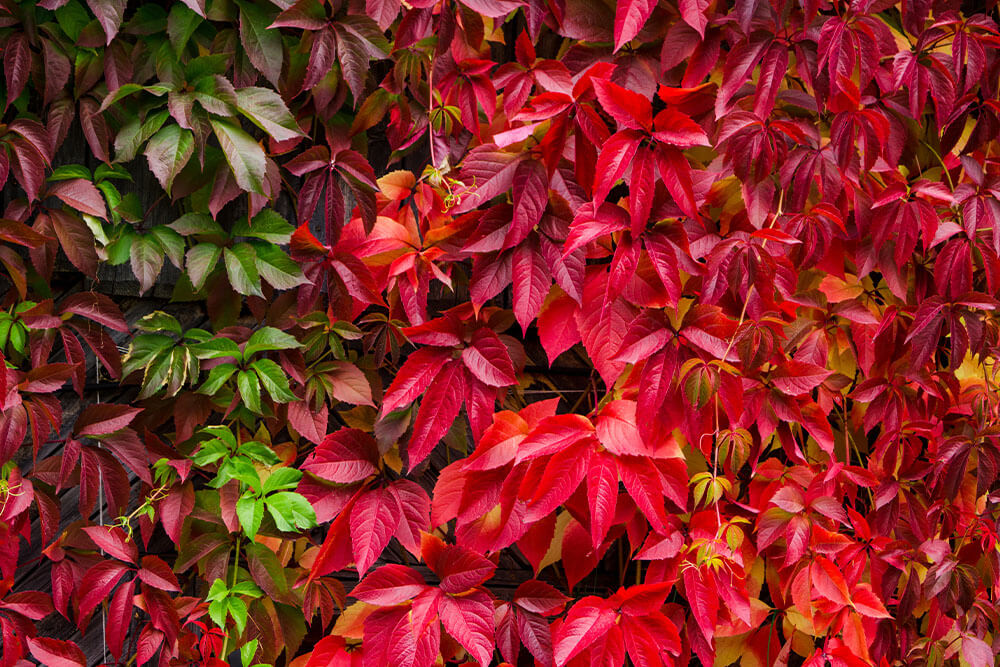
Here we have another climbing plant that also proves to be a salt-tolerant option as well. The Virginia creeper, unlike some other vines on this list, is a native species throughout much of the United States, which means it is not only a beautiful planting option, but also one that will benefit your local ecosystem. The Virginia Creeper plant has deciduous leaves that consist of a set of five prominent leaflets. Throughout most of the year, those leaves will have a typical green color, but in the fall, they usually turn red, which only adds to the attractiveness and seasonal appeal of this plant.
19. White Oak (Quercus alba)

There are few shade trees that are as majestic at maturity as the white oak tree. This species not only grows to incredible heights but also develops a canopy that is equally expansive. Those large spreading branches allow the white oak to cast a broad area of shade that is the perfect place to get some relief from the sun after spending time at the beach. Like the other oaks on this list, the white oak tree does not mind living in an area where salt is present, but whether you have high salinity conditions or not, planting a white oak is perhaps the best way to add an elegant shade tree to your property.
20. Winterberry (Ilex verticillata)
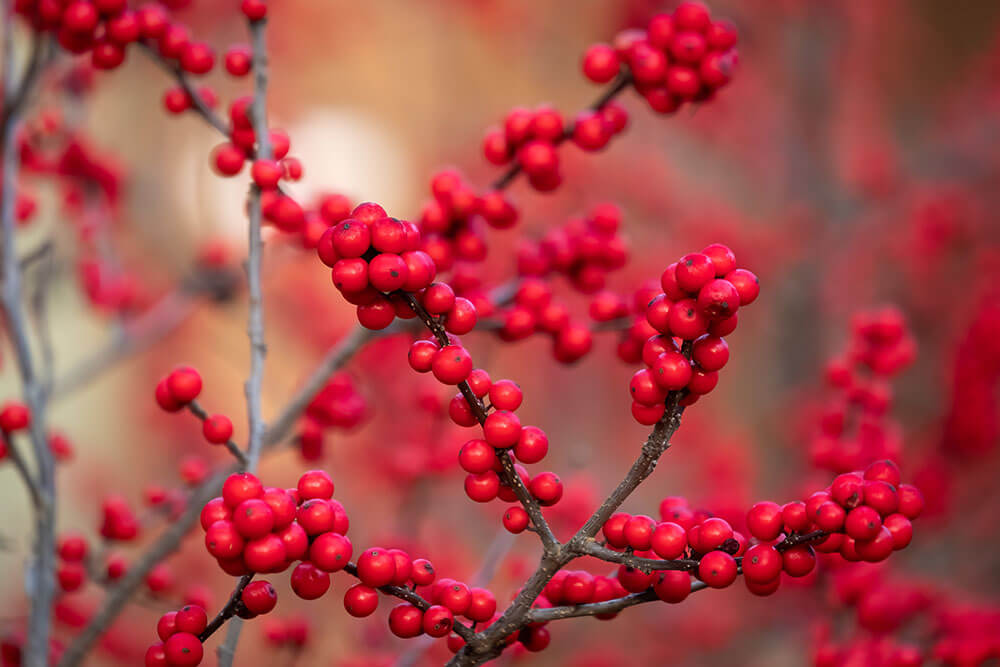
Beach landscapes often look best during the hottest months of the year. However, for those who live near the beach year-round, it is important to include plants that will provide interest in the winter as well. As its name implies, the winterberry shrub is one of the best species for this role. Winterberry shrubs hold bright red berries during the coldest parts of the year, and they are salt-tolerant as well. However, if you want to witness those impressive fruits, you’ll need to plant both male and female versions of this plant.
21. Yucca (Yucca filamentosa)

Although yucca plants, also known as Adam’s needle, look like they belong in hot deserts, these plants are surprisingly adaptable to colder regions, surviving throughout hardiness zones 4 through 10. Along with this unexpected cold tolerance, yucca plants are also able to thrive in salty conditions as well. However, resilience and adaptability are not the primary reasons why people grow this plant. Instead, what gives the yucca plant its popularity is its unique appearance. Overall, this plant looks like a set of spiky leaves that form a ball shape that is about three feet in diameter.
Are you interested in learning even more about the best salt-tolerant plants for beach landscaping even after reading through our list of the 21 best options? If so, the next few sections may help to satisfy your curiosity about these fantastic and varied plants as we’ll be answering a few of the most commonly asked questions that gardeners of all experience levels have about this topic.
Frequently Asked Questions About Salt-Tolerant Plants for Beach Landscaping
Which Plant is the Most Tolerant to Salty Conditions?
While there are many plants that are salt-tolerant to some degree, there remain some that are far more salt-tolerant than others. This variation in tolerance is the reason why some plants can only grow relatively close to the ocean while others can grow directly on the shoreline. For example, shrubs such as the rugosa rose, and the bayberry often grow on dunes near the ocean, thanks in large part to the high salt tolerance of these plants.
Is There a Plant That Absorbs Salt?
Since there are many plants that cannot survive in salty soils, we have an incentive to find a way to remedy soils by removing their salt. There are a few potential methods to achieve this, and using plants for absorption is one of the options. However, using plants to effectively absorb salt from the ground remains a potential for the future rather than a reliable practice in the current day.
What Plants Are Resistant to Salinity?
There are plenty of plants that are resistant to salinity, and they come from many different plant groups, including trees, shrubs, vines, annuals, and herbaceous perennials. Additionally, salt-tolerant plants can come from different regions of the world. However, many of the most popular salt-tolerant plants are native to coastal or desert areas.
What Trees Grow Best Near Salt Water?
Finding trees that can grow near salt water is a bit of a challenge, but it is far from an impossible task. In fact, there are several popular trees that are salt-tolerant. Perhaps most notably, there are several oak tree species that can grow near salt water, including the red, white, and pin oaks.
Are Succulents Salt Tolerant?
The term succulents refers to a large family of plants that share a few similar traits and growing preferences. Some of these plants may not enjoy salty conditions, but most of them are relatively salt-tolerant. However, since these plants require warm temperatures year-round, it is more likely that you will need to grow them indoors where there is likely lower salinity.
21 Diverse Salt-Tolerant Plants for Beach Landscaping that You Should Get to Know
If you live near the ocean and you want to plant a garden, you may have once believed that efforts to find plants that thrive in your location are destined to be fruitless. However, that is not the case at all. As our list of 21 salt-tolerant plants for beach landscaping reveals, there are plenty of plant options at your disposal, even if you live near the ocean.


